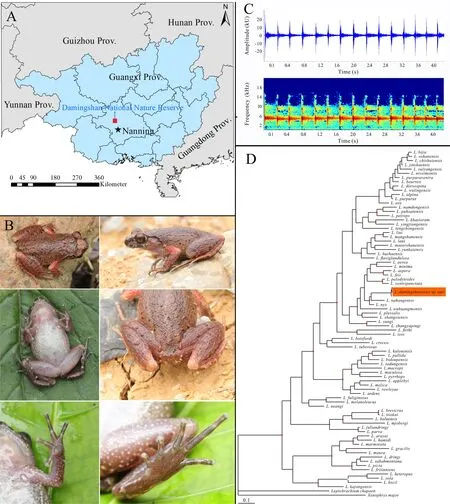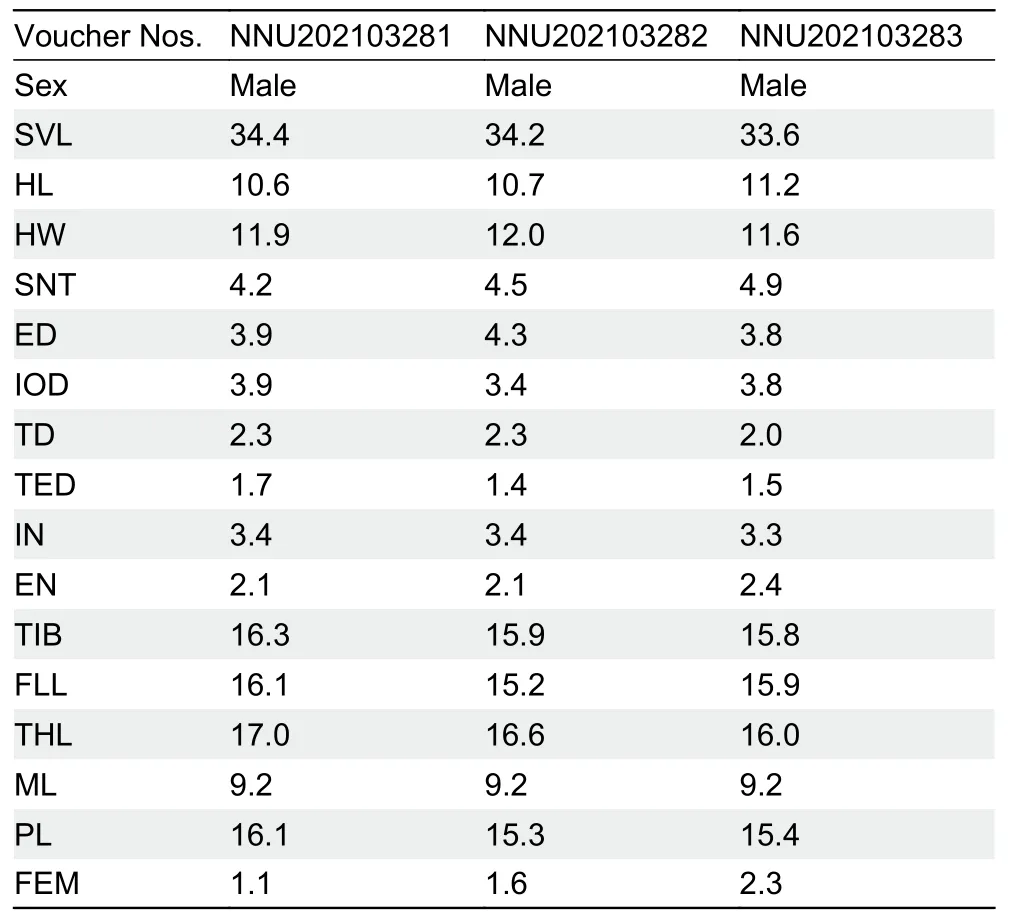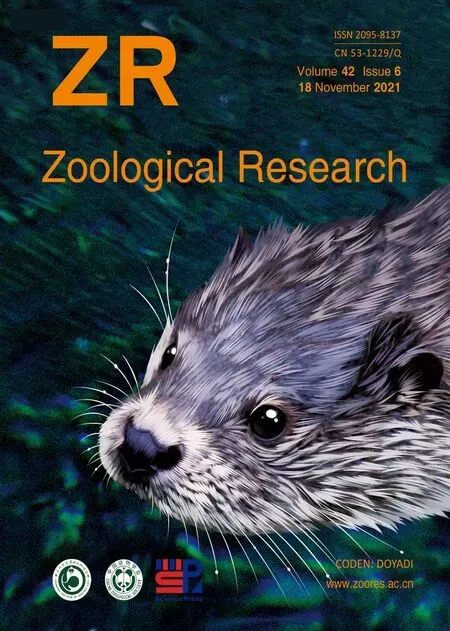A new species of Leptobrachella (Anura:Megophryidae) from central Guangxi, China
Wei-Cai Chen, Gui-Dong Yu, Zhi-Ying Cheng,Tao Meng, Hai Wei, Guang-Yong Zhou, Yan-Wu Lu
1 Key Laboratory of Environment Change and Resources Use in Beibu Gulf Ministry of Education, Nanning Normal University,Nanning, Guangxi 530001, China
2 Guangxi Key Laboratory of Earth Surface Processes and Intelligent Simulation, Nanning Normal University, Nanning,Guangxi 530001, China
3 Guangxi Forest Inventory and Planning Institute, Nanning,Guangxi 530001, China
4 Damingshan National Nature Reserve of Guangxi, Wuming,Guangxi 530114, China
A new species of the genusLeptobrachella,Leptobrachella damingshanensissp.nov.is described from central Guangxi,China, based on morphological, molecular, and acoustic data.Phylogenetic analyses using a 16S rRNA gene fragment indicated that the new species formed an independent clade close toL.nahangensisandL.nyx.However, the new species differs from all known congeners based on a combination of the following characters: medium size (snout-vent length(SVL) 33.6–34.4 mm in males); pair of distinct jacinth humeral glands on proximal thigh area; rough dorsal skin with sparse jacinth tubercles and several short longitudinal ridges; creamy white ventral surface with small, creamy white glands on throat, chest, belly, and ventral surfaces of thighs, becoming more concentrated near lateral margin; webbing and lateral fringes absent on fingers, toes with rudimentary webbing and narrow lateral fringes; flanks with small irregular black spots;iris bicolored, upper half copper, fading to silver in lower half.Uncorrectedp-distances were greater than 4.7% betweenLeptobrachelladamingshanensissp.nov.and all homologous DNA sequences available for the 16S rRNA gene.The new species is only known to occur in the Damingshan National Nature Reserve, where it inhabits montane evergreen forests between 1 000–1 200 m a.s.l.
The genusLeptobrachellaSmith 1925 currently includes 89 species, found on the islands of Southeast Asia to the eastern Himalayas (Frost, 2021).Given their small body size,morphological conservatism, and enigmatic behavior,Leptobrachellaspecies diversity is likely underestimated(AmphibiaChina, 2021; Chen et al., 2018, 2020; Stuart &Rowley, 2020; Wang et al., 2020).Recently, using molecular and/or acoustic analyses, many new species ofLeptobrachellahave been discovered and described (Chen et al., 2019, 2020, 2021; Cheng et al., 2021; Nguyen et al., 2021;Qian et al., 2020; Shi et al., 2021).More than 41% ofLeptobrachellaspecies (37 out of 89) have been reported in the last five years (Frost, 2021).In China, there are 32 known species ofLeptobrachella: i.e.,L.alpina(Fei, Ye & Li, 1990),L.asperaWang, Lyu, Qi & Wang, 2020,L.bashaensisLyu,Dai, Wei, He, Yuan, Shi, Zhou, Ran, Kuang, Guo, Wei &Yuan, 2020,L.bijieWang, Li, Li, Chen & Wang, 2019,L.bourreti(Dubois, 1983),L.chishuiensisLi, Liu, Wei & Wang,2020,L.dorsospinaWang, Lyu, Qi & Wang, 2020,L.eos(Ohler, Wollenberg, Grosjean, Hendrix, Vences, Ziegler &Dubois, 2011),L.feiiChen, Yuan & Che, 2020,L.flaviglandulosaChen, Yuan & Che, 2020,L.jinshaensisCheng, Shi, Li, Liu, Li & Wang, 2021,L.laui(Sung, Yang &Wang, 2014),L.liui(Fei & Ye, 1990),L.mangshanensis(Hou,Zhang, Hu, Li, Shi, Chen, Mo & Wang, 2018),L.maoershanensis(Yuan, Sun, Chen, Rowley & Che, 2017),L.niveimontisChen, Poyarkov, Yuan & Che, 2020,L.nyx(Ohler,Wollenberg, Grosjean, Hendrix, Vences, Ziegler & Dubois,2011),L.oshanensis(Liu, 1950),L.pelodytoides(Boulenger,1893),L.purpuraventraWang, Li, Li, Chen & Wang, 2019,L.purpurus(Yang, Zeng & Wang, 2018),L.shangsiensisChen,Liao, Zhou & Mo, 2019,L.shiwandashanensisChen, Peng,Pan, Liao, Liu & Huang, 2021,L.suiyangensisLuo, Xiao, Gao& Zhou, 2020,L.sungi(Lathrop, Murphy, Orlov & Ho, 1998),L.tengchongensis(Yang, Wang, Chen & Rao, 2016),L.ventripunctata(Fei, Ye & Li, 1990),L.wuhuangmontisWang,Yang & Wang, 2018,L.wulingensisQian, Xiao, Cao, Xia &Yang, 2020,L.yeaeShi, Hou, Song, Jiang & Wang, 2021,L.yingjiangensis(Yang, Zeng & Wang, 2018), andL.yunkaiensisWang, Li, Lyu & Wang, 2018.Most of these species have been discovered and reported in the last three years (AmphibiaChina, 2021; Frost, 2021).

Figure 1 Type locality, morphological characters, advertisement calls, and molecular phylogenetic tree of Leptobrachella damingshanensis sp.nov.
During fieldwork in 2021, we collected three frog specimens from the Damingshan National Nature Reserve (DMS),Wuming County, Guangxi, China (Figure 1A).The specimens were deposited at Nanning Normal University (NNU) and measured after fixation in 10% formalin, with subsequent storage in 75% ethanol.Muscle tissues were stored in 100% ethanol for DNA extraction.Measurements were obtained with a digital caliper to the nearest 0.1 mm.Measurements followed Rowley et al.(2016) and included the following: SVL;head length from tip of snout to rear of jaw (HL); head width at commissure of jaw (HW); snout length from tip of snout to anterior eye corner (SNT); diameter of exposed portion of eyeball (ED); interorbital distance (IOD); horizontal diameter of tympanum (TD); distance from anterior edge of tympanum to posterior eye corner (TED); internarial space distance (IN);distance from eye front to nostril (EN); tibia length with flexed hindlimb (TIB); forelimb length from elbow to tip of third finger(FLL); thigh length from vent to knee (THL); manus length from tip of third digit to proximal edge of inner palmar tubercle(ML); pes length from tip of fourth toe to proximal edge of inner metatarsal tubercle (PL); and maximum diameter of femoral gland (FEM).Sex was determined by direct observation of calling in life or presence of internal vocal sac openings.We obtained comparative morphological data from museum specimens (Supplementary Table S1) and previous publications on the genusLeptobrachella(Supplementary Table S2).
Genomic DNA was isolated from muscle tissues using Qiagen DNeasy tissue extraction kits (Germany).We used the primers reported in Palumbi et al.(1991) to amplify a fragment of the 16S rRNA gene.Polymerase chain reaction (PCR)amplification was performed in a 25 μL volume with the following protocols: initial denaturation step at 94 °C for 3 min,35 cycles of denaturation at 94 °C for 30 s, annealing at 58 °C for 30 s, extension at 72 °C for 40 s, and final extension at 72°C for 10 min.The PCR products were directly sequenced using an ABI PRISM 3730 DNA Analyzer (Applied Biosystems, USA).The new sequences were submitted to BLAST to ensure the target fragments had been amplified(Altschul et al., 1997) and were then deposited in GenBank(accession Nos.MZ145229–MZ145231).Phylogenetic relationships were analyzed using Bayesian inference (BI)with MrBayes v3.2 (Ronquist et al., 2012).We used MrModeltest v2.3 (Nylander, 2004) to select the best-fit evolutionary model (GTR+I+G) for 16S rRNA based on the Akaike Information Criterion.Two independent runs with four Markov Chain Monte Carlo simulations were conducted for 10 million iterations and sampling was performed at every 1 000thiteration.The first 25% of samples were discarded as burn-in.Uncorrected pairwise sequence divergence (p-distance) was performed using Mega v7 (Kumar et al., 2016) with default settings.The sequence matrix of the 16S rRNA gene was 534 bp (Supplementary Table S3).
Acoustic data were recorded using a Sony ICD-TX50 recorder (Japan).The temperature during recording was~23°C.Advertisement calls of the holotype were recorded in the field.We used Raven Pro v1.6 (Cornell Laboratory of Ornithology, USA) to analyze the call recordings, as per K?hler et al.(2017) and Rowley et al.(2016).Audiospectrograms were calculated using a fast-Fourier transform(FFT) of 512 points, 50% overlap, 172 Hz grid-spacing, and Hanning windows (Rowley et al., 2016).
The phylogenetic tree revealed that the specimens formed an independent clade with robust support and were closest toL.nahangensisandL.nyx.Uncorrectedp-distances were greater than 4.7% between the specimens and all homologous DNA sequences available for the 16S gene (Supplementary Table S4).However, the specimens differed fromL.nahangensisandL.nyxby flanks with small irregular black spots and rough, brownish-red dorsal skin with sparse jacinth tubercles and several short longitudinal ridges.The specimens could also be distinguished from all other known congeners(see taxonomic account below).Additionally, its advertisement calls differed from those of its congeners.Diagnostic morphological characters, mtDNA analyses, and acoustic data(Figure 1B–D) indicated that these specimens were distinct from their congeners in China and adjoining countries.Herein,we describe these specimens as a new species.
Taxonomic account
Leptobrachella damingshanensis sp.nov.(Figure 1B)
Holotype:NNU202103281, adult male (Figure 1B), collected at Damingshan National Nature Reserve, Wuming County,Guangxi, China (N23.471o, E108.436o; 1 145 m a.s.l.).Collected by Wei-Cai Chen on 25 April 2021.
Paratypes:NNU202103282–3, two adult males collected at same locality as holotype on 25 April 2021 by Wei-Cai Chen.
Etymology:The species epithet ‘damingshanensis’ refers to the type locality, Damingshan National Nature Reserve,Guangxi, China.The suggested English name is Damingshan Leaf Litter Toad, and the Chinese name is Da Ming Shan Zhang Tu Chan (大明山掌突蟾)
Diagnosis:The specimens were assigned to the genusLeptobrachellabased on the following characters: small size,presence of inner metacarpal tubercle and macro-glands on body (including supra-axillary and femoral), and absence of vomerine teeth (Dubois, 1980, 1983; Lathrop et al., 1998;Rowley & Trung, 2009; Rowley et al., 2013).Leptobrachella damingshanensissp.nov.can be distinguished from its congeners by a combination of the following: medium size(SVL 33.6–34.4 mm in males); pair of distinct jacinth humeral glands on proximal thigh area; rough dorsal skin with sparse jacinth tubercles and several short longitudinal ridges; creamy white ventral surface with small, creamy white glands on throat, chest, belly, and ventral surfaces of thighs, becoming more concentrated near lateral margin; webbing and lateral fringes absent on fingers, toes with rudimentary webbing and narrow lateral fringes; flanks with small irregular black spots;iris bicolored, upper half copper, fading to silver in lower half.
Description of holotype:Head length less than width(HW/HL=1.13); snout bluntly rounded in profile and dorsal view, projecting slightly over lower jaw; nostril oval shaped,closer to tip of snout than eye; canthus rostralis distinct; loreal region distinctly sloping, slightly concave; pupil vertical; eye diameter less than length of snout (ED/SNT=0.93); tympanum distinct and rounded, diameter approximately 58% that of eye;tympanic rim slightly elevated relative to skin of temporal region; vomerine teeth absent; medium tongue with shallow notch at posterior tip; distinct raised supratympanic fold from corner of eye to supra-axillary gland (Figure 1B).
Tips of fingers slightly swollen; relative finger lengths I<II<IV<III; subarticular tubercles absent; prominent inner palmar tubercle, separated from small outer palmar tubercle;finger webbing and dermal fringes absent.Tips of toes rounded, slightly swollen; relative toe lengths I<II<V<III<IV;subarticular tubercles absent, replaced by dermal ridges;prominent and oval inner metatarsal tubercle; outer metatarsal tubercle absent; toe webbing rudimentary; lateral fringes narrow.Tibia 48% of SVL; tibiotarsal articulation reaching middle of eye.
Dorsal surface of skin rough with small, raised tubercles and ridges, ridges more evident on shoulder and dorsal surfaces of limbs; upper eyelid with small tubercles; ventral surface creamy white with small, creamy white glands on throat, chest,belly, and ventral surfaces of thighs, becoming more concentrated near lateral margin; pectoral glands oval,approximately 1.5 mm in diameter; femoral glands oval,approximately 2.3 mm in diameter, located on posteroventral surface of thighs, closer to knee than to vent; supra-axillary glands distinct and oval, approximately 1.8 mm in diameter;humeral glands oval, approximately 1.6 mm in diameter,located on proximal thigh area, and ventrolateral glandular line distinct (Figure 1B).
Color of holotype in life:Dorsum brownish red with dark brown markings, especially between eyes, with distinct brown inverse triangle-shaped marking and shoulders with irregular patch; tympanum brown; supratympanic fold black with jacinth line from posterior corner of eye to supra-axillary glands;creamy white posterior corner of eye; wide brown bars on upper lip; flanks with small irregular black spots; indistinct transverse dark brown bars on dorsal surface of hindlimbs;elbows, upper arms, tibiotarsus surfaces, and lateral surfaces of fingers and toes orange; creamy white ventral surface with small, creamy white glands on throat, chest, belly, and ventral surfaces of thighs, becoming more concentrated near lateral margin; creamy white pectoral and femoral glands, creamy white supra-axillary glands with orange spot, jacinth humeral glands; pupil black; iris bicolored, upper half copper, fading to silver in lower half (Figure 1B).
Color of holotype in preservative:Dorsum and limb surfaces faded to uniform medium brown.Dark-brown, inverse triangle-shaped marking distinctly visible; small irregular black spots on flanks distinct.Throat, chest, and belly with creamy white spots.Pectoral, femoral, supra-axillary, and ventrolateral glands creamy white, humeral glands and upper arms pale orange.
Secondary sexual characters:Vocal sac openings located laterally on floor of mouth; nuptial pad on fingers absent.
Variation:Measurements of type series are shown in Table 1.Holotype and paratypes are similar in body size and color pattern.NNU202103283 has denser creamy white glands on belly, especially on lateral margin; black spots on flanks are variable.
Advertisement call:Calls of the holotype were recorded at an ambient temperature of 23 °C.Calls consisted of a single note, with a dominant frequency of 4.6–5.2 kHz.Call duration was 294.1 ms (294.1±19.4 ms,n=40); call interval was 228.7 ms (228.7±37.7 ms,n=40); and call repetition rate was 3.3(Supplementary Table S5) (Figure 1C).
Measurements of holotype(in mm): SVL 34.4, HL 10.6, HW 11.9, SNT 4.2, ED 3.9, IOD 3.9, TD 2.3, TED 1.7, IN 3.4, EN 2.1, TIB 16.3, FLL 16.1, THL 17.0, ML 9.2, PL 16.1, FEM 1.1.
Ecology and distribution:The new species were located in an evergreen forest at DMS at an elevation of 1 000–1 200 m a.s.l.We recorded males calling on rocks near rocky streams between 2000–2400 h.Currently,Leptobrachella damingshanensissp.nov.is only known from DMS.
Comparison:Supplementary Table S6 provides the brief diagnostic morphological characters of 63 recognizedLeptobrachellaspecies occurring north of the Isthmus of Kra.Firstly,Leptobrachelladamingshanensissp.nov.can be distinguished from its phylogenetically close congenersL.aerea,L.alpina,L.feii,L.minima,L.nahangensis,L.nyx,L.pelodytoides,L.pluvialis,L.shangsiensis,L.sungi,L.ventripunctata,L.wuhuangmontis, andL.zhangyapingi(Figure 1D) based on: medium body size (SVL 33.6–34.4 mm in males); distinct jacinth humeral glands on proximal thigh area; creamy white ventral surface; no webbing or lateral fringes on fingers; toes with rudimentary webbing and narrow lateral fringes; flanks with small irregular black spots; and iris bicolored.Leptobrachelladamingshanensissp.nov.is phylogenetically closest toL.nahangensisandL.nyx(Figure 1D).However,Leptobrachelladamingshanensissp.nov.differs fromL.nahangensisby relatively small body size(SVL 33.6–34.4 mm vs.SVL 40.8 mm in males); flanks with small irregular black spots (vs.flanks with line of several large spots); presence of distinct inverse triangle-shaped marking between eyes (vs.lavender-brown dorsum with prominent,irregular mottling); narrow lateral fringes on toes (vs.no lateral fringes on toes); digits without transverse dark bars (vs.digits with transverse dark bars); and iris bicolored, upper half copper, fading to silver in lower half (vs.iris gold, uniformly distributed with minute black reticulations).Leptobrachella damingshanensissp.nov.differs fromL.nyxby distinct ventrolateral glandular ridges (vs.lateroventral glandular ridge poorly distinct); rough, brownish-red dorsal skin with sparse jacinth tubercles and several short longitudinal ridges (vs.grayish-brown dorsum with dark, regularly set, rounded spots and dorsal skin with flat glandular warts); flanks with small irregular black spots (vs.flanks with poorly distinct spots);narrow lateral fringes on toes (vs.no lateral fringes on toes);creamy white ventral surface with small creamy white glands on throat, chest, belly, and ventral surfaces of thighs,becoming more concentrated near lateral margin (vs.ventral side whitish with brown borders).Leptobrachella damingshanensissp.nov.differs fromL.aerea,L.alpineandL.zhangyapingiby narrow lateral fringes on toes (vs.wide lateral fringes on toes) and fromL.minimaandL.pluvialisby narrow lateral fringes on toes (vs.no lateral fringes on toes).Leptobrachelladamingshanensissp.nov.differs fromL.aereaandL.zhangyapingiby black spots on flanks present(vs.absent).The new species differs fromL.aerea,L.alpina,L.feii,L.pluvialis,L.shangsiensis,L.ventripunctata, andL.wuhuangmontisby relatively large body size (SVL 33.6–34.4 mm vs.<30 mm in males).Leptobrachelladamingshanensissp.nov.differs fromL.sungiandL.zhangyapingiby relatively small body size (SVL 33.6–34.4 mm vs.>40 mm in males).Leptobrachelladamingshanensissp.nov.differs fromL.pelodytoidesandL.sungiby rudimentary webbing on toes (vs.wide).

Table 1 Measurements of Leptobrachella damingshanensis sp.nov.(in mm)
Leptobrachelladamingshanensissp.nov.also differs from the remainingLeptobrachellaspecies north of the Isthmus of Kra based on medium body size (SVL 33.6–34.4 mm in males) (vs.smaller body size inL.applebyi,L.ardens,L.aspera,L.bashaensis,L.bidoupensis,L.crocea,L.dorsospina,L.firthi,L.flaviglandulosa,L.graminicola,L.isos,L.khasiorum,L.lateralis,L.laui,L.liui,L.maculosa,L.mangshanensis,L.melica,L.niveimontis,L.pallida,L.petrops,L.puhoatensis,L.purpurus,L.rowleyae,L.tadungensis,L.tengchongensis,L.tuberosa, andL.yingjiangensis); narrow lateral fringes on toes (vs.wide lateral fringes on toes inL.alpine,L.eos,L.firthi,L.graminicola,L.isos,L.khasiorum,L.laui,L.liui,L.purpurus,L.tamdil,L.yingjiangensis, andL.yunkaiensis; vs.without lateral fringes on toes inL.applebyi,L.ardens,L.crocea,L.kalonensis,L.lateralis,L.macrops,L.maculosa,L.melica,L.namdongensis,L.neangi,L.oshanensis,L.pallida,L.pyrrhops,L.rowleyae,L.tadungensis, andL.tuberosa); black spots on flanks (vs.black spots on flanks absent inL.botsfordi,L.crocea,L.eos,L.firthi,L.graminicola,L.isos,L.pallida,L.petrops,L.tuberosa, andL.zhangyapingi) (see details in Supplementary Table S6).
Finally, based on dominant frequency, call duration, and call interval,Leptobrachelladamingshanensissp.nov.displayed distinct differences from its phylogenetically close congeners(see details in Supplementary Table S5).
NOMENCLATURAL ACTS REGISTRATION
The electronic version of this article in portable document format represents a published work according to the International Commission on Zoological Nomenclature (ICZN);hence, the new names contained in the electronic version are effectively published under that Code from the electronic edition alone (see Articles 8.5–8.6 of the Code).This published work and the nomenclatural acts it contains have been registered in ZooBank, the online registration system for the ICZN.The ZooBank Life Science Identifiers (LSIDs) can be resolved, and the associated information can be viewed through any standard web browser by appending the LSID to the prefixhttp://zoobank.org/.
Publication LSID:
urn:lsid:zoobank.org:pub:A02601F7-2446-4B63-BF93-33AC E34DD17E
LeptobrachelladamingshanensisLSID:
urn:lsid:zoobank.org:act:71362523-B09C-4886-9D07-643F2A9CC33E
SCIENTIFIC FIELD SURVEY PERMISSION INFORMATIONPermission for field surveys was granted by the Administration Bureau of Damingshan National Nature Reserve of Guangxi.
SUPPLEMENTARY DATA
Supplementary data to this article can be found online.
COMPETING INTERESTS
The authors declare that they have no competing interests.
AUTHORS’ CONTRIBUTIONS
W.C.C.designed the study and wrote the manuscript.G.D.Y.,Z.Y.C., T.M., H.W., G.Y.Z., and Y.W.L.took part in fieldwork.All authors read and approved the final version of the manuscript.
ACKNOWLEDGMENTS
We are grateful to Li Lin and Hao Zhang from the Damingshan National Nature Reserve for field assistance.We also thank two anonymous reviewers for improving the manuscript.
- Zoological Research的其它文章
- Site-specific and seasonal variation in habitat use of Eurasian otters (Lutra lutra) in western China:implications for conservation
- Challenging Wallacean and Linnean shortfalls:Ectatosticta spiders (Araneae, Hypochilidae)from China
- High-quality chromosome-level genome assembly of redlip mullet (Planiliza haematocheila)
- Understanding autism spectrum disorders with animal models: applications, insights, and perspectives
- A new species of Micryletta (Amphibia: Anura:Microhylidae) from the Langbian Plateau in southern Vietnam
- Novel rhino-like SHJHhr mice with thyroid dysfunction

